#cotton wool
Text

UPDATE: Children not being hurt is woke now
#The Sun#Woke#Things that are woke now#Children#Not being hurt#That’s woke now#Wokeness#Schools#Metal bars#Concrete#The 1950s#Good for them#Toughened them up#Character building#Broken bones#No!#Just stop falling#Kids today#Cotton wool#BASTARDS
10 notes
·
View notes
Text

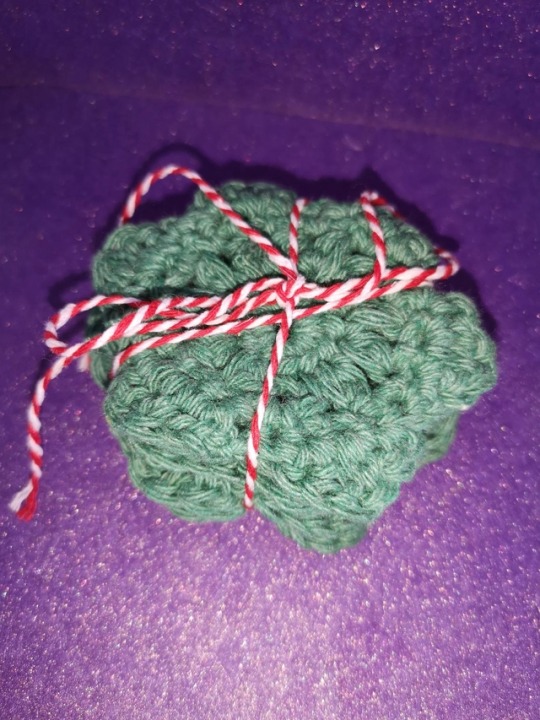
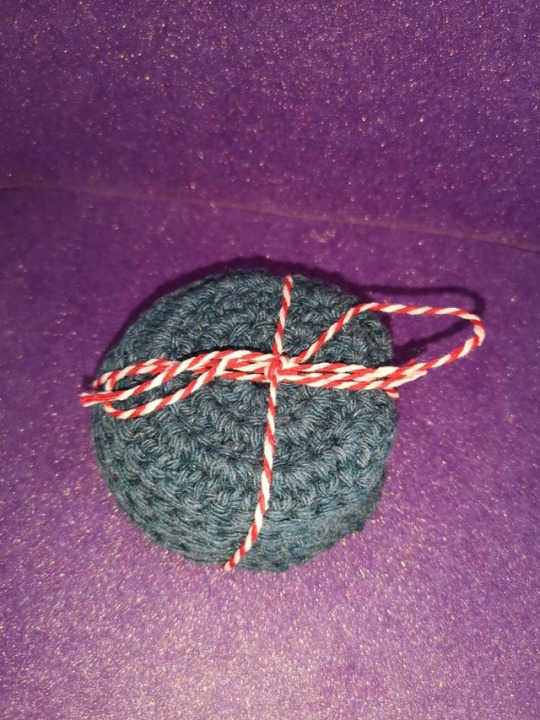
Cotton face scrubs, 80% recycled cotton, 20% recycled polyester, 100% reusable.
These come in packs of 5 and are perfect for helping protect the planet against single use face wipes ending up in landfill! - Made by M, posted by M
#wool#cotton wool#cotton yarn#crochet#face scrub#face wash#bath#bathtub#cleaning#wool art#yarn#yarn crafts#yarnblr#wool crafts#practical crafts#queer owned business#disabled owned business
1 note
·
View note
Text
It’s just a ball of cotton wool.
*VERY LOUD AND INDESCRIBABLE CACOPHONY OF HEAD-SPLITTING EARDRUM SHATTERING NOISE*
Never mind, I take it BACK!!!!!!!!!!!!!!!!
#dougie rambles#personal stuff#my poor attempt at a joke#what#no context#loud noises#cotton#cotton wool#mostly harmless#or not#unreality
1 note
·
View note
Text
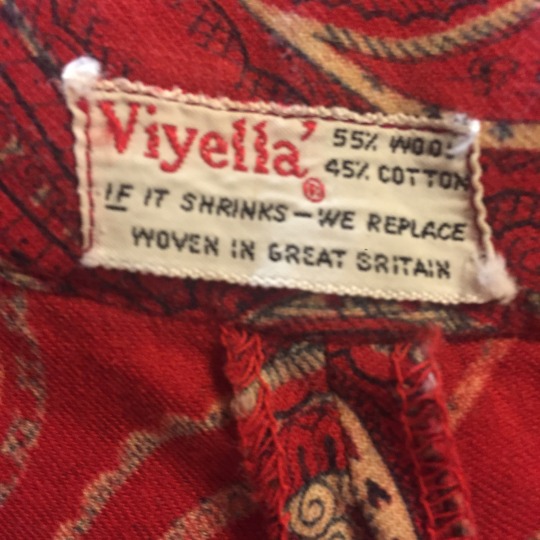
IF it shrinks— we replace
0 notes
Text
youtube
#птенцы#в гнезде#своими руками#гнездышко#птенчик#птичка#поделка#из ваты#гнездо#cotton wool#chicks#diy#Youtube
0 notes
Text

I MADE A THING
homegrown cotton -> homespun & plied thread -> a little piece of lace :)
#needle lace#rolemodel: míriel#not to waste my precious cotton i was practising on cotton wool#unprocessed cotton was ridiculously easy to use after that :D#considering that this is the very first attempt it worked just fine#a little uneven but I'm learning#the spinning is fun but plying is a paaaainnn
5K notes
·
View notes
Text
#cottonballs#cotton yarn#cotton wool#cotton#cotton pads#cotton production#yarns and threads#yarn manufacturers in india#yarn manufacturers
1 note
·
View note
Text

Thinking about Disco Elysium and stars. Something about communal experience and simultaneous isolation, hope and idealism, fear and beauty and terror and burning. The inherent horror in the vast romantic starscape of the sky, the melancholy and loneliness inherent in the untold distance, a communal experience of something too enormous to fathom. Stars bear witness to humanity, to the millions of tiny people crawling on the face of Elysium. They watch the people, and the people watch back, and make up stories about the stars. Stars symbolise love, hope, something unreachable and unattainable.









The way that the light of the stars reaches every single being in Elysium, from human to phasmid, but no matter how far it reaches it is still a cold and distant glow, always on the verge of going out. A moral brilliance, a holy light to strive towards, something always at risk of burning out, but there's a dichotomy too. A duality between the stars as brutal unfeeling observers, moralists even, like the aerostatics flying overhead, tiny dying lights that watch impassively over every terrible thing in the world, and the flipside; stars as the burning kernels of hope, furious burning flames that parallel Harry and his golden-orange forest fire nature. Stars as the light of communism, the star-and-antlers. They're hope and dreams- a million years in the stars. Rockstars and superstars. The light of a brighter future (however short-term that future might be) coming towards them at the end of the tunnel. It makes me think of Sacred and Terrible Air and the light pollution in Vassa- ending light pollution as the world ends. "You may laugh at this, but in the evening, when the big world in the distance swells into a bloody maelstrom, families come out into the street in Vaasa and are insignificant together. Only distant explosions disturb the deep peace of the winter night, its flawless starry sky. Everyone watches, heads tilted back." The stars are a shared experience. Something that everyone watches, insignificant together, when there's nothing more that can be done. Light in the face of darkness, community in the face of inevitability. Togetherness. The stars are there in the church with the ravers. They're there watching Harry and Kim together. Insignificant together. In dark times, should the stars also go out?






#i'm collecting quotes for another thing and i just like all of these together idk#disco elysium#de rambling#my brain is so full of cotton wool rn so sorry if this is. garbled sddjjdsk#long post#i am really sorry for the incessant longposts#sacred and terrible air spoilers#pjõl spoilers#i guess? also very much oversimplifying there#i just. idk. i have feelings about that bit#it's the team ibex translation btw#stars manage to encapsulate both moralism and communism lol- inaction+distant observation versus fire and passion and feeling
498 notes
·
View notes
Note
How did cotton win over linen anyway?
In short, colonialism, slavery and the industrial revolution. In length:
Cotton doesn't grow in Europe so before the Modern Era, cotton was rare and used in small quantities for specific purposes (lining doublets for example). The thing with cotton is, that's it can be printed with dye very easily. The colors are bright and they don't fade easily. With wool and silk fabrics, which were the more traditional fabrics for outer wear in Europe (silk for upper classes of course), patterns usually needed to be embroidered or woven to the cloth to last, which was very expensive. Wool is extremely hard to print to anything detailed that would stay even with modern technology. Silk can be printed easily today with screen printing, but before late 18th century the technique wasn't known in western world (it was invented in China a millenium ago) and the available methods didn't yeld good results.
So when in the late 17th century European trading companies were establishing trading posts in India, a huge producer of cotton fabrics, suddenly cotton was much more available in Europe. Indian calico cotton, which was sturdy and cheap and was painted or printed with colorful and intricate floral patters, chintz, especially caught on and became very fashionable. The popular Orientalism of the time also contributed to it becoming fasionable, chintz was seen as "exotic" and therefore appealing.
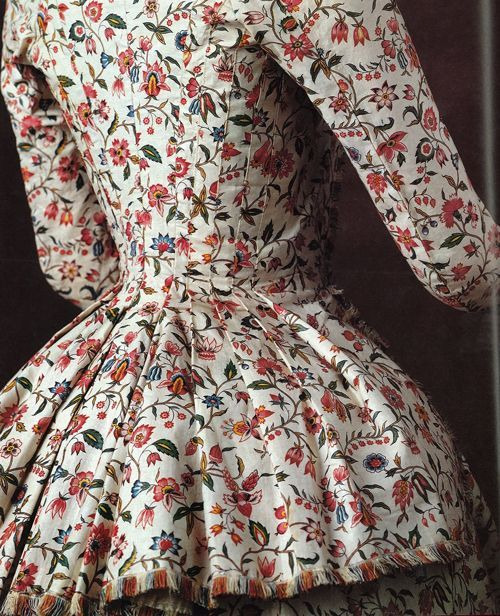
Here's a typical calico jacket from late 18th century. The ones in European markets often had white background, but red background was also fairly common.
The problem with this was that this was not great for the business of the European fabric producers, especially silk producers in France and wool producers in England, who before were dominating the European textile market and didn't like that they now had competition. So European countries imposed trade restrictions for Indian cotton, England banning cotton almost fully in 1721. Since the introduction of Indian cottons, there had been attempts to recreate it in Europe with little success. They didn't have nearly advanced enough fabric printing and cotton weaving techniques to match the level of Indian calico. Cotton trade with India didn't end though. The European trading companies would export Indian cottons to West African market to fund the trans-Atlantic slave trade that was growing quickly. European cottons were also imported to Africa. At first they didn't have great demand as they were so lacking compared to Indian cotton, but by the mid 1700s quality of English cotton had improved enough to be competitive.
Inventions in industrial textile machinery, specifically spinning jenny in 1780s and water frame in 1770s, would finally give England the advantages they needed to conquer the cotton market. These inventions allowed producing very cheap but good quality cotton and fabric printing, which would finally produce decent imitations of Indian calico in large quantities. Around the same time in mid 1700s, The East Indian Company had taken over Bengal and soon following most of the Indian sub-continent, effectively putting it under British colonial rule (but with a corporate rule dystopian twist). So when industrialized English cotton took over the market, The East India Company would suppress Indian textile industry to utilize Indian raw cotton production for English textile industry and then import cotton textiles back to India. In 1750s India's exports were mainly fine cotton and silk, but during the next century Indian export would become mostly raw materials. They effectively de-industrialized India to industrialize England further.
India, most notably Bengal area, had been an international textile hub for millennia, producing the finest cottons and silks with extremely advance techniques. Loosing cotton textile industry devastated Indian local economies and eradicated many traditional textile craft skills. Perhaps the most glaring example is that of Dhaka muslin. Named after the city in Bengal it was produced in, it was extremely fine and thin cotton requiring very complicated and time consuming spinning process, painstakingly meticulous hand-weaving process and a very specific breed of cotton. It was basically transparent as seen depicted in this Mughal painting from early 17th century.
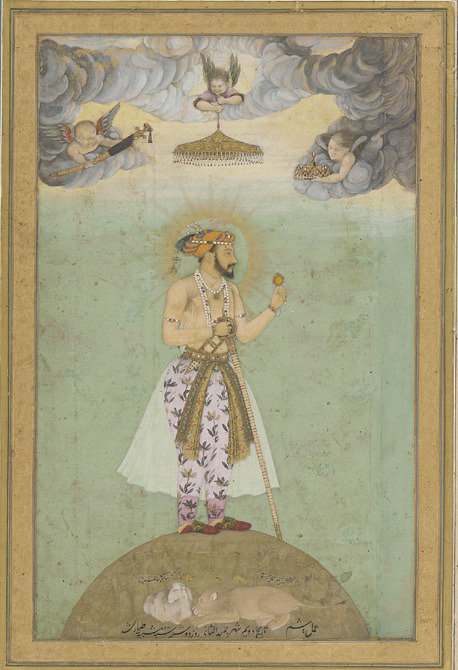
It was used by e.g. the ancient Greeks, Mughal emperors and, while the methods and it's production was systematically being destroyed by the British to squash competition, it became super fashionable in Europe. It was extremely expensive, even more so than silk, which is probably why it became so popular among the rich. In 1780s Marie Antoinette famously and scandalously wore chemise a la reine made from multiple layers of Dhaka muslin. In 1790s, when the empire silhouette took over, it became even more popular, continuing to the very early 1800s, till Dhaka muslin production fully collapsed and the knowledge and skill to produce it were lost. But earlier this year, after years lasting research to revive the Dhaka muslin funded by Bangladeshi government, they actually recreated it after finding the right right cotton plant and gathering spinners and weavers skilled in traditional craft to train with it. (It's super cool and I'm making a whole post about it (it has been in the making for months now) so I won't extend this post more.)


Marie Antoinette in the famous painting with wearing Dhaka muslin in 1783, and empress Joséphine Bonaparte in 1801 also wearing Dhaka muslin.
While the trans-Atlantic slave trade was partly funded by the cotton trade and industrial English cotton, the slave trade would also be used to bolster the emerging English cotton industry by forcing African slaves to work in the cotton plantations of Southern US. This produced even more (and cheaper (again slave labor)) raw material, which allowed the quick upward scaling of the cotton factories in Britain. Cotton was what really kicked off the industrial revolution, and it started in England, because they colonized their biggest competitor India and therefore were able to take hold of the whole cotton market and fund rapid industrialization.
Eventually the availability of cotton, increase in ready-made clothing and the luxurious reputation of cotton lead to cotton underwear replacing linen underwear (and eventually sheets) (the far superior option for the reasons I talked about here) in early Victorian Era. Before Victorian era underwear was very practical, just simple rectangles and triangles sewn together. It was just meant to protect the outer clothing and the skin, and it wasn't seen anyway, so why put the relatively scarce resources into making it pretty? Well, by the mid 1800s England was basically fully industrialized and resource were not scarce anymore. Middle class was increasing during the Victorian Era and, after the hard won battles of the workers movement, the conditions of workers was improving a bit. That combined with decrease in prices of clothing, most people were able to partake in fashion. This of course led to the upper classes finding new ways to separate themselves from lower classes. One of these things was getting fancy underwear. Fine cotton kept the fancy reputation it had gained first as an exotic new commodity in late 17th century and then in Regency Era as the extremely expensive fabric of queens and empresses. Cotton also is softer than linen, and therefore was seen as more luxurious against skin. So cotton shifts became the fancier shifts. At the same time cotton drawers were becoming common additional underwear for women.
It wouldn't stay as an upper class thing, because as said cotton was cheap and available. Ready-made clothing also helped spread the fancier cotton underwear, as then you could buy fairly cheaply pretty underwear and you didn't even have to put extra effort into it's decoration. At the same time cotton industry was massive and powerful and very much eager to promote cotton underwear as it would make a very steady and long lasting demand for cotton.
In conclusion, cotton has a dark and bloody history and it didn't become the standard underwear fabric for very good reasons.
Here's couple of excellent sources regarding the history of cotton industry:
The European Response to Indian Cottons, Prasannan Parthasarathi
INDIAN COTTON MILLS AND THE BRITISH ECONOMIC POLICY, 1854-1894, Rajib Lochan Sahoo
#i have fixed the wording in the beginning so it doesn't sound like i'm saying cotton in general dyed better than wool or silk#answers#fashion history#historical fashion#history#textile history#dress history#historical clothing#indian history#colonial history#indian textiles#cotton#slavery
2K notes
·
View notes
Text
thinking about how I had a few folks at my last market suggest to me (kindly and with good intentions) that I make and sell some versions of the hand knit cardigan I was wearing because people would "totally pay $300 for that!"
I appreciated the sentiment, but people don't understand what goes into handmade clothes! I don't use a knitting machine. Every stitch in that garment is created by hand on needles, and the sleeves were brioche. Even using inexpensive acrylic yarn for the whole project, and accounting for the HUGE sleeve stitches (saving me time making the sleeves)—the material cost was $55 and the labor was well beyond that.
Let's conservatively estimate the cardigan took me 30 hours to create. Currently, when pressed to put a dollar amount to my time, I use the living wage as a baseline and then go up from there $1/hour for every year I have been actively practicing that particular skill. In the case of knitting that would be 11 years, and the current living wage in my area is approximately $23/hour. Setting aside the fact that this is calculated based on a 40 hour work week and I don't believe that is ethical or sustainable, we'll just leave it at $34/hour. That would make labor alone $1,020.
This brings the "production cost" to $1,075.
Items are not sold at production cost because that would leave your profit margin at 0%. This is not sustainable because it costs money to run a business (think things like paying for computer repairs, buying tools, the tablecloth you use at markets, paying for a website, etc.). Realistically to cover business costs and still come out with a 7% "net" profit margin, which is just a number pulled from averages in the clothing retail business...
... I'd have to sell that cardigan for $1,350.
So yeah! Something to think about when you see the price of clothes that are handmade. :o)
#and this is for something made with PLASTIC yarn!! not cotton! not wool! not really ethical even though it's technically#slow fashion#this is why garments were originally intended to last a LIFETIME or even generations!!!!#they are not cheap! clothes should proportionately be one of the singularly most expensive things we own btw!!#thank you for coming to my talk#I will be ranting again about this in the future I'm sure#handmade fashion#small business#fast fashion#shop small#etsy seller#knitting#fiber art#handmade life#fashion#indie fashion#style#strawberrum chirps
92 notes
·
View notes
Text
thinking about puppet tattoo parlors. A wall covered in so many different thread colors to choose from - swatches of different types of stitch for different textures / effects. modified handheld sewing machines for tattooing with multiple settings for the different stitches. individual needles + embroidery thread as stick n pokes...
#THINKING SO HARD ABOUT THIS#wouldnt this be cool though???#cause i was thinking fondly of tattoos and went 'hm. how would a puppet do this?'#cause ink can bleed in fabric. it can scrub out. the lines wouldnt be as clean and i just dont think it would really Stick?#but EMBROIDERY! STITCHES! COOL SEWING GUNS INSTEAD OF TATTOO MACHINES!!!#and now im wondering Could They Remove Their Tattoos?#it would probably be pretty invasive!#hold on im doing research real quick#yeah looks like they'd need to lift their felt/fleece/skin to get at the back of the stitches#then sew the skin back together afterwards...#so to them tattoos would be just as permanent as they are to Us! because who wants to go through That!#im having a grand ol time imagining the Range their tattoos would have#textures! endless colors! glitter thread! metallic thread! wool! cotton! polyester! glow in the dark! scratch n sniff!#that last one was a joke.#imagining someone with an entire detailed forest scene carpeting their back... it has Depth...#absolutely unprompted#puppets#sundown summer is getting a motherfuckin tattoo if its the last thing i do#resisting the urge to just litter every puppet that i know of with this idea#YOU get a tattoo and YOU get a tattoo and YOU-
123 notes
·
View notes
Note
your dread piece makes me nauseous with recognition. there's been so many times when i've been in a happy situation with people i love and im just struck with emotional agony, and i cant say a word. too real. fantastic work.
.
#thank you!#I know the feeling all too well so it's nice to hear I was able to convey it effectively#answered#anonymous#cw mental health talk#I personally struggle with panic attacks and occasional autistic shutdowns and they just put you in the weirdest headspaces#especially when you're out with someone and suddenly the world is falling apart and your head is full of cotton wool and thumbtacks#and you forget how to speak so there's no way to communicate your distress or ask for a breather#things just speed wildly past you and you can't process any of it#and you know from previous experiences that it's just a panic attack it's harmless it'll pass soon#but at that moment you sure feel like you're about to lose your mind or die#doesn't feel good wouldn't recommend
314 notes
·
View notes
Text
Fuck it Friday/Inspiration Saturday
Well I'm officially back at uni and therefore officially completely incapable of writing more than 100 words a day 💀 I've got another snip of zoo fic for you guys today, plus one of the videos that's helped me write it. Gonna require a LOT of hyping up for this cause I'm gonna try finish it tomorrow and it's just not working out for me 😅
Tagged for FIF by @spotsandsocks @exhuastedpigeon @aroeddiediaz @cal-daisies-and-briars @daffi-990 and @tizniz (count this as your inspiration saturday tag friends)
youtube
Eddie is bought swiftly from his thoughts as a murmur goes up through the crowd and Christopher leans over Buck to excitedly tap at Eddie’s leg, effectively getting his attention.
“Dad, look! They’re coming out!”
Eddie trains his attention towards the enclosure and, sure enough, a long snout pokes out of the large doorway in the wall, followed by, Eddie had to admit, the most majestic looking animal he’d seen in a good long while (Buck included).
The mama hippo happily plods into the enclosure, making an immediate beeline to the small pile of lettuce, carrots, grass, pellets and watermelon slices. Her body sways from side to side as she walks, pausing to nose at the undergrowth, before merrily continuing along her path for food. Just as she’s about to reach her bounty, she stills, turning her large head towards the doorway. There, just in the bottom right hand corner, a tiny head with small, crinkled ears and a blunt nose pokes out, small brown eyes swivelling this way and that as she takes in the new environment.
Sensing her baby’s hesitance, the mama hippo makes her way back across the enclosure and nudges the baby with her nose, gently encouraging her forward. An “awwww” ripples through the crowd as the baby cautiously picks her way forward, shoving her nose in the foliage on the side of the wee path as she explores. She’s so tiny she barely comes up to her mother’s belly, and her footsteps are so small that she almost has to run to keep up with her mother, pitter pattering behind her as she’s led to the middle of the enclosure.
“Eds, look, isn’t that the most adorable thing you’ve seen?” Buck queries as he turns to Eddie, his eyes so wide and full of wonder and innocence, making Eddie want to tuck him under his arm and keep him safe forever.
“Yeah,” Eddie agrees huskily, watching as the baby hippo carefully dips a toe into the water before lowering her snout, a small spout of water misting on either side of her nostrils as she accidentally breathes in the water and huffs it out. “Yeah, it is.”
tagging @theotherbuckley @hippolotamus @watchyourbuck @disasterbuckdiaz @puppyboybuckley @bucksbackwardcap @fortheloveofbuddie @jesuisici33 @steadfastsaturnsrings @wikiangela @buckbuckgoose @wildlife4life @slightlyobsessedwitheverything @evanbegins @alliaskisthepossibilityoflove @rainbow-nerdss @kitteneddiediaz @elvensorceress @epicbuddieficrecs @smilingbuckley @actuallyitsellie @thekristen999
#zoo fic#my brain feels a bit like it's made of cotton wool#but I am determined to finish this!#buddie#eddie diaz#evan buckley#911 abc#911 buddie#911verse#911 fanfic#911#eddie x buck#Youtube
66 notes
·
View notes
Photo

Kilt Ensemble
Graingar & Campbell of George Street, Edinburgh
c.1862
Royal Ontario Museum (Object number: 2020.64.1-6)
#kilt#menswear#mensfashion#fashion history#historical fashion#1860s#victorian#victorian fashion#19th century#plaid#tartan#scotland#ensemble#wool#cotton#red#blue#black#royal ontario museum
266 notes
·
View notes
Text
‘joe’s the romantic’ nicolò di genova knew nile for the grand total of ten minutes before going all ‘love of my life’ ‘meant to find each other’. the romantic is both of them because they are both absolute simps
#down so bad they might as well be in hell#hes so soft hes cotton wool#the old guard#kaysanova#immortal husbands#nicky di genova#joe al kaysani#nicolo di genova#yusuf al kaysani
363 notes
·
View notes
Text
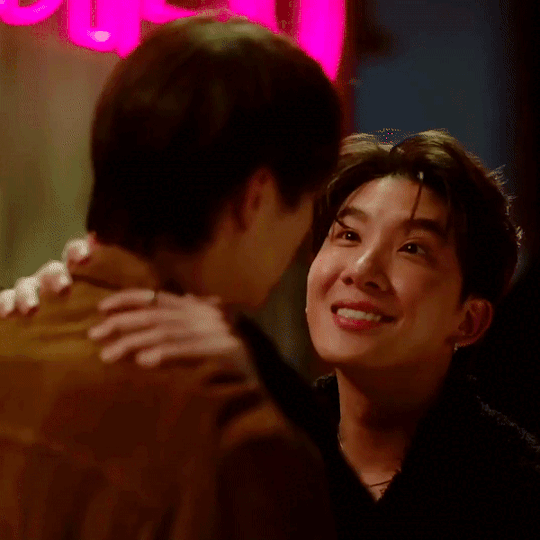
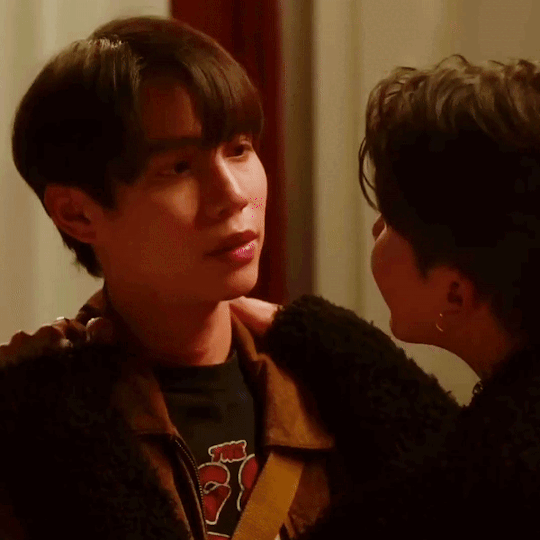
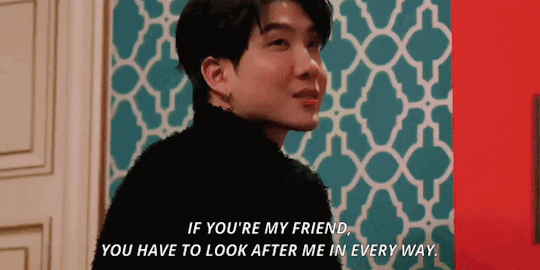


Only Friends Episode 2 | "You have to look after me in every way."
You've got your hands full Sand. But isn't he just precious???
#only friends#only friends the series#ofts#ray x sand#sand x ray#raysan#sanray#khaofirst#firstkhao#first kanaphan#khaotung thanawat#he's a needy baby okay?#i love him so much#i will commit crimes for you#wrap him up in cotton wool
150 notes
·
View notes